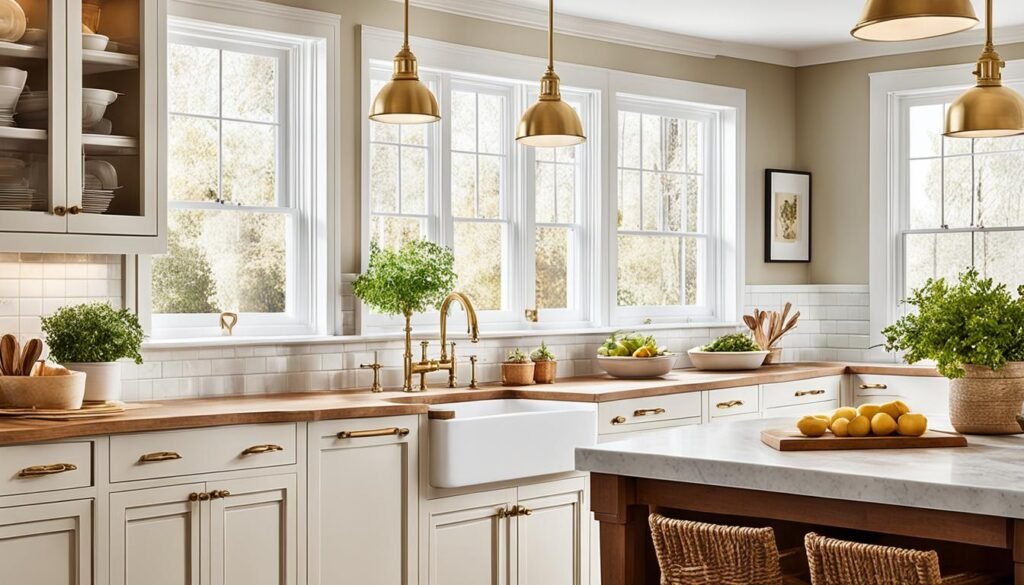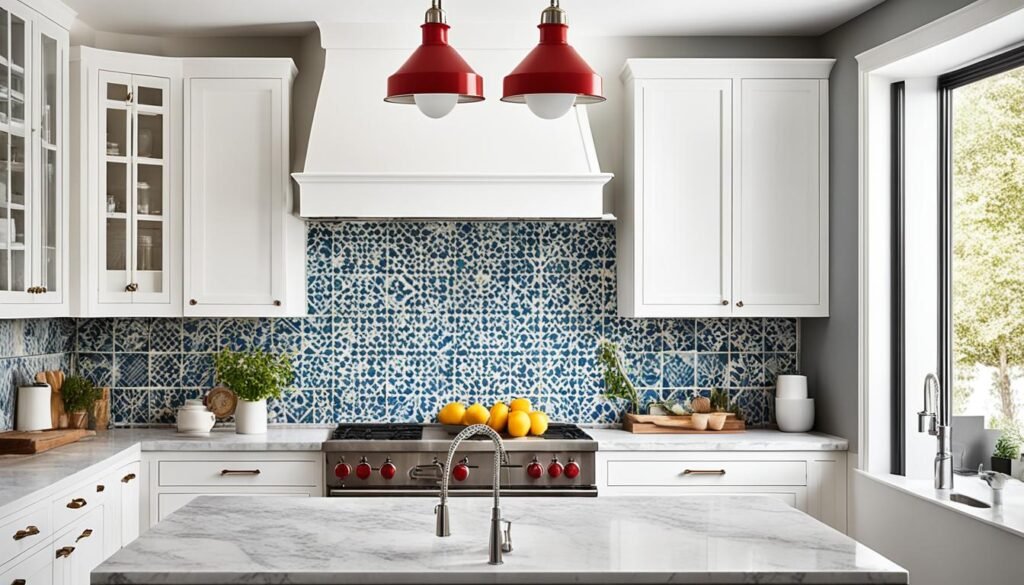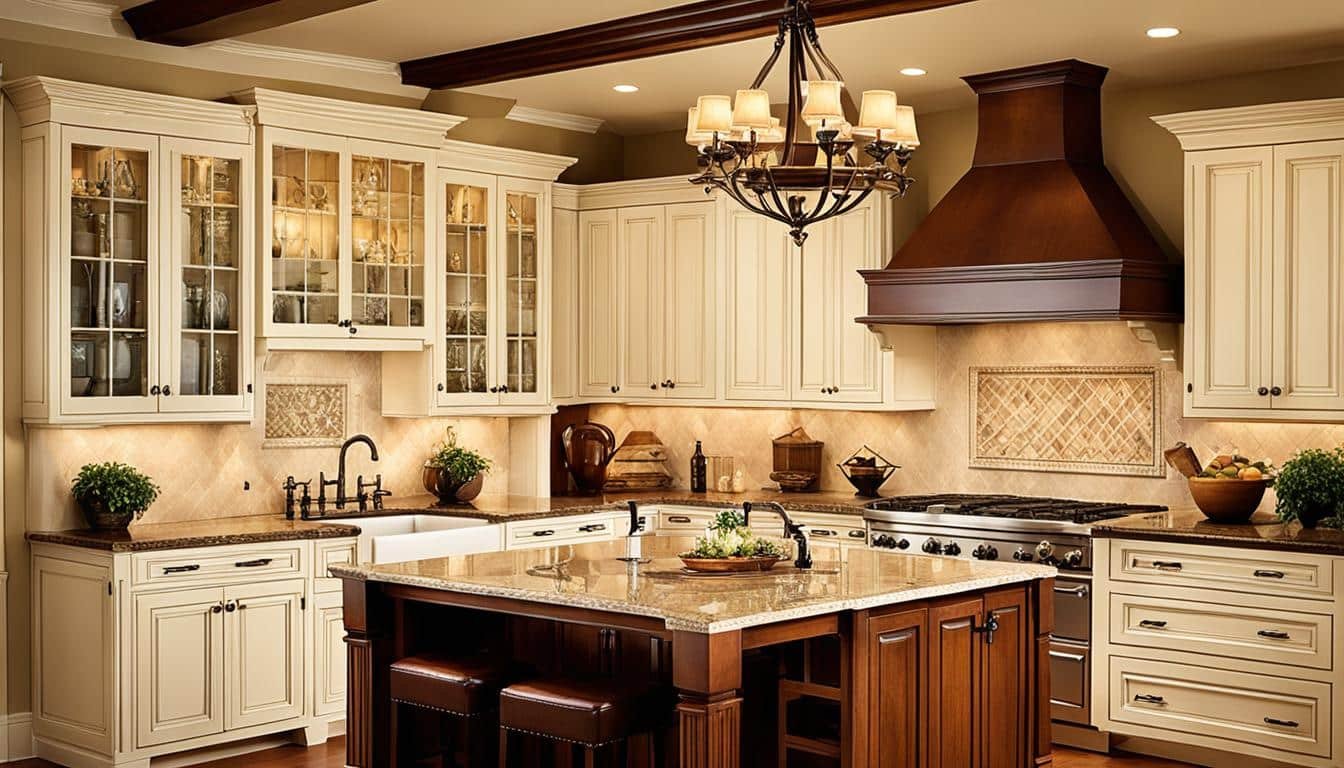Traditional kitchen design is a popular choice for many homeowners who want a classic and elegant look for their kitchen. It combines functionality with timeless style to create a heartwarming space that never goes out of fashion. With quality craftsmanship, effective use of space, and natural materials, traditional kitchens have a charm that is hard to resist. Let’s explore some traditional kitchen design ideas that will inspire you to create a classic and elegant kitchen space.
Key Takeaways:
- Traditional kitchen design offers a classic and elegant look for your kitchen.
- It combines functionality with timeless style and creates a heartwarming space.
- Quality craftsmanship, effective use of space, and natural materials are key elements of traditional kitchen design.
- Consider the layout, cabinets, finishes, lighting, and flooring to create a cohesive and inviting traditional kitchen space.
- Traditional kitchen design can be infused with contemporary elements for a fresh and modern twist.
Elements of Traditional Kitchen Design
Traditional kitchen design embodies a timeless style that exudes classic elegance. It is characterized by a careful balance of quality craftsmanship, effective use of space, natural materials, and enduring decorative details. Let’s delve into the key elements that define traditional kitchen design.
Quality Craftsmanship
Traditional kitchens prioritize quality craftsmanship, ensuring that every aspect of the design is meticulously executed. From the intricate carvings on cabinetry to the precise joinery of countertops, attention to detail is paramount. This commitment to craftsmanship creates a sense of refinement and durability in a traditional kitchen.
Effective Use of Space
Traditional kitchens make efficient use of space, optimizing every inch for functionality and practicality. The layout and organization of cabinets, countertops, and appliances are carefully considered to enhance workflow and ease of use. This thoughtful approach results in a kitchen that is both aesthetically pleasing and highly functional.
Natural Materials
The use of natural materials is a hallmark of traditional kitchen design. Natural woods, such as oak and cherry, are commonly utilized for cabinetry and flooring, adding warmth and character to the space. Stone, such as marble or granite, is often incorporated in countertops and backsplashes, lending a touch of elegance and timelessness.
“Traditional kitchens embrace the beauty of natural materials, creating a warm and inviting atmosphere that stands the test of time.” – Design Expert
Enduring Decorative Details
To enhance the charm and character of a traditional kitchen, enduring decorative details are incorporated. Antique furniture and vintage-inspired fixtures add a touch of nostalgia and sophistication. Ornate moldings, intricate tile work, and decorative hardware further contribute to the timeless aesthetic of a traditional kitchen.
Traditional Kitchen Layout and Design Ideas

When it comes to designing a traditional kitchen, the layout is crucial. A functional kitchen layout is essential to ensure that the space is both family-friendly and comfortable. By carefully considering the placement of appliances, work areas, and storage, you can create a kitchen that is easy to navigate and use.
Start by thinking about the workflow in your kitchen. Consider the classic “work triangle” concept, where the refrigerator, sink, and stove are positioned in a triangular layout to make food preparation more efficient. This traditional kitchen layout allows for a seamless flow from one area to another, ensuring that everything is within reach.
A functional kitchen layout is the foundation of a well-designed traditional kitchen. It allows you to easily move between tasks and ensures that everything you need is conveniently located. Whether you’re cooking a family meal or entertaining guests, a carefully planned layout can make all the difference.
Another important aspect to consider in a traditional kitchen layout is the choice of materials and finishes. Countertops and cabinetry play a significant role in the overall look and feel of the space. Opt for durable materials such as granite or quartz countertops that not only provide a beautiful aesthetic but are also easy to clean and maintain.
For cabinetry, choose timeless styles that complement the traditional theme of your kitchen. Consider raised panel doors, decorative molding, and quality hardware to add elegance and sophistication. These details are what give a traditional kitchen its signature charm.
Additionally, incorporating a kitchen island can enhance both the functionality and style of a traditional kitchen. An island provides extra countertop space for meal preparation and can also serve as a gathering spot for family and friends. It can be used as a breakfast bar or a place for casual dining, making it a versatile addition to your kitchen.
When planning your traditional kitchen remodel, remember that the layout should prioritize functionality, convenience, and comfort. By considering the placement of appliances, work areas, and storage, and by choosing the right materials and finishes, you can create a traditional kitchen that is both beautiful and practical.
Traditional Kitchen Cabinets and Storage Solutions

One of the essential elements of a traditional kitchen design is the selection of cabinets and storage solutions. Traditional kitchen cabinets not only provide functionality but also contribute to the overall aesthetic appeal of the space. With their attention to detail and timeless design, traditional kitchen cabinets create a sense of elegance and sophistication.
Paneling and molding are commonly used to enhance the visual appeal of traditional kitchen cabinets. These decorative details add depth and texture, elevating the overall design. The panels can be intricately carved or have simple raised patterns, depending on the desired level of embellishment.
Glass-front cabinets are a hallmark of traditional kitchen design. They not only serve as a display for fine china and decorative items but also add a touch of openness and airiness to the space. Glass-front cabinets create an opportunity to showcase cherished collectibles and add a personal touch to the kitchen.
To further infuse a traditional charm into the kitchen, incorporating antique furniture is a wonderful option. A built-in island or a freestanding table can serve as both a functional and decorative piece. These antique furniture pieces bring a sense of history and character to the kitchen while offering additional storage solutions.
By carefully selecting traditional kitchen cabinets and storage solutions, homeowners can create a kitchen that seamlessly blends practicality with timeless elegance.
Traditional Kitchen Finishes and Materials

Traditional kitchens are known for their timeless charm and attention to detail. One of the key elements that contribute to their classic look is the choice of finishes and materials. By selecting the right finishes, you can create a kitchen that exudes warmth, elegance, and sophistication.
Natural Woods
In traditional kitchens, natural woods are often used for cabinetry and flooring. Materials like oak and cherry not only add a touch of natural beauty but also bring warmth and character to the space. The richness and grain patterns of these woods create a sense of authenticity and craftsmanship that is synonymous with traditional design.
Marble
When it comes to countertops and backsplashes, marble is a popular choice in traditional kitchens. With its luxurious appearance and timeless appeal, marble adds an elegant and sophisticated touch to the space. Whether it’s a classic white marble or a striking veined variety, this natural stone complements the traditional aesthetic seamlessly.
White Cabinets
White cabinets are a staple in traditional kitchen design. They create a clean and bright look that enhances the overall aesthetic of the space. The simplicity of white cabinets allows other design elements to shine, making it easy to incorporate different finishes and accents into the kitchen.
Brass Accents
To add a touch of old-world charm and elegance, brass accents are often incorporated into traditional kitchens. Whether it’s cabinet hardware, faucets, or lighting fixtures, brass adds a warm and inviting element to the space. It can also create a beautiful contrast against the natural wood and white cabinetry.
Vintage-Style Fixtures
In traditional kitchens, vintage-style fixtures are a popular choice to enhance the overall charm of the space. Whether it’s a pendant light, a farmhouse sink, or a bridge-style faucet, these fixtures add a sense of nostalgia and timeless appeal. They can be the perfect finishing touch that ties all the design elements together.
Beamed Ceiling
A beamed ceiling is a traditional architectural feature that adds character and interest to a kitchen. Whether they are exposed wooden beams or faux beams, they create a sense of warmth and authenticity. They can be left in their natural wood finish or painted to match the color scheme of the kitchen.
By carefully selecting and combining these traditional finishes and materials, you can create a kitchen that is both functional and visually appealing. The right finishes will enhance the timeless charm and classic elegance of your traditional kitchen, making it a welcoming space for family and friends to gather.
Traditional Kitchen Color Schemes and Accents

When it comes to traditional kitchen design, the color scheme plays an important role in creating a timeless and elegant space. A popular choice for traditional kitchens is a white and gray palette that provides a versatile backdrop for the room. The use of white and gray tones ensures that the kitchen will never go out of style and can easily accommodate changes in decor over time.
While white and gray set the foundation, pops of color can be incorporated to add visual interest and personality to the space. One way to introduce color is through accessories and accents. Consider adding a vibrant bowl of fresh fruits or a bouquet of flowers to add a lively touch. These small bursts of color can enliven the overall look and create a welcoming atmosphere in the kitchen.
A patterned runner or rug can also inject color and texture into a traditional kitchen. Choose a design that complements the existing color palette and adds visual interest to the floor area. Not only does this solution bring warmth and style, but it also helps to protect the floors.
Another way to add a touch of elegance and sophistication is by incorporating decorative corners on the backsplash or cabinets. These decorative corners can be intricate scrollwork, carved details, or embossed designs that accentuate the traditional style of the kitchen. They serve as subtle yet eye-catching elements that elevate the overall aesthetic.
“The decorative corners on the cabinets and backsplash add a touch of elegance and sophistication to the traditional kitchen design.”
Lastly, showcasing antique collections can bring character and authenticity to a traditional kitchen. Displaying vintage artwork, blue-and-white china, or other cherished pieces creates a sense of history and adds a personal touch. These collections can be showcased on open shelves, in glass-front cabinets, or as decorative accents throughout the kitchen.
Overall, traditional kitchen color schemes and accents play a crucial role in setting the tone and atmosphere of the space. By incorporating a white and gray palette as the foundation, adding pops of color, utilizing patterned runners, incorporating decorative corners, and showcasing antique collections, you can create a traditional kitchen that exudes timeless charm and character.
Traditional Kitchen Lighting and Decor

When it comes to traditional kitchen design, lighting plays a crucial role in creating the perfect ambiance. Choosing the right lighting fixtures can enhance the overall aesthetic and add a touch of elegance and charm to the space. In this section, we will explore the importance of traditional kitchen lighting and how it can be combined with decor to create a warm and inviting atmosphere.
Simple Styles and Elegance
In traditional kitchens, simple lighting styles are often preferred to complement the overall aesthetic of the space. Lanterns and pendant lights are popular choices that exude a timeless charm. Their classic designs and warm glow add a touch of elegance to the kitchen, creating a cozy and inviting atmosphere for cooking and entertaining.
Choose lighting fixtures in simple styles to enhance the traditional look and feel of your kitchen. Lanterns and pendant lights are perfect for creating an atmosphere of timeless elegance.
Embracing Natural Light
In addition to artificial lighting fixtures, natural light is essential in creating a warm and inviting traditional kitchen. Consider incorporating windows or skylights strategically to maximize the amount of natural light in the space. Natural light not only illuminates the kitchen but also highlights its natural beauty and architectural details.
Focal Point with Original Artwork
Add a personal touch to your traditional kitchen by incorporating original artwork. Choose pieces that resonate with the style and ambiance of the space. Whether it’s a painting, sculpture, or photography, original artwork can create a focal point and add character to your kitchen. Select pieces that reflect your taste and bring joy to the heart of your home.
Incorporating the SEO Keywords
When designing a traditional kitchen, it is important to consider the lighting and decor. Traditional kitchen lighting fixtures, such as lanterns and pendant lights, add a touch of elegance and charm. Embracing natural light through windows or skylights creates a warm and inviting atmosphere. Original artwork serves as a focal point, adding a personal touch and character to the space.
Traditional Kitchen Flooring and Countertops

When designing a traditional kitchen, it is essential to carefully consider the selection of flooring and countertops. These elements not only contribute to the overall aesthetic but also play a crucial role in creating a durable and timeless space.
Wood Floors: Classic Warmth and Character
Wood floors are a staple in traditional kitchen design. They bring warmth, character, and a touch of natural beauty to the space. Whether you prefer rich hardwoods like oak or the grain patterns of cherry, wood floors add a timeless appeal that complements the traditional style.
With proper care and maintenance, wood floors can endure for many years, providing a sturdy and reliable foundation for your kitchen. They can withstand heavy foot traffic and are resistant to spills and stains, making them an ideal choice for a busy kitchen environment. Additionally, wood floors add a sense of comfort and coziness that enhances the overall ambiance.
Marble Countertops: Luxurious Elegance
For those seeking an elegant and luxurious look, marble countertops are an excellent choice. The natural beauty and distinctive veining of marble create a stunning focal point in any traditional kitchen. The timeless appeal of marble adds a touch of sophistication and opulence, elevating the overall aesthetic.
Marble countertops are known for their durability and heat resistance, making them perfect for a functional kitchen. However, it’s important to note that marble is a porous material and can be prone to staining. Regular sealing and proper maintenance can help protect its beauty and ensure its longevity.
Natural Stone: Rustic and Earthy Charm
If you prefer a more rustic and earthy feel in your traditional kitchen, natural stone countertops are an excellent option. The unique variations and textures found in materials like granite, soapstone, or slate add depth and character to the space.
Natural stone offers durability and resilience, making it a suitable choice for countertops in a traditional kitchen. Its ability to withstand heat, scratches, and daily wear and tear ensures that it will maintain its enduring beauty for years to come.
In addition to countertops, natural stone can also be utilized for backsplashes or flooring, creating a cohesive and harmonious look throughout the kitchen.
Choosing enduring materials such as wood floors, marble countertops, or natural stone ensures that your traditional kitchen will stand the test of time both in terms of style and functionality. These materials not only exude classic elegance but also provide a lasting foundation for your culinary endeavors.
Traditional Kitchen Design with a Twist

Traditional kitchen design doesn’t have to be limited to a strictly traditional aesthetic. By adding contemporary elements, you can give your traditional kitchen a fresh and modern twist that reflects your personal style.
One way to introduce a contemporary touch is by incorporating geometric tile patterns for the backsplash or flooring. Geometric tiles add visual interest and create a focal point in the kitchen, adding a unique and modern element to the traditional design.
Another way to infuse a modern twist is by experimenting with unexpected colors. Consider incorporating bold blues or vibrant greens into your traditional kitchen to create a striking and personalized look. These unexpected color choices can add a contemporary flair and make your kitchen stand out.
To further enhance the modern twist, mixing finishes can add texture and depth to your traditional kitchen design. Combine matte and shiny surfaces in your cabinetry, countertops, or fixtures to create contrast and visual interest. This mix of finishes adds a contemporary edge while complementing the timeless charm of traditional design.
By incorporating contemporary elements such as geometric tile, unexpected color choices, and mixed finishes, you can create a traditional kitchen with a twist. This fusion of classic and modern design elements will give your kitchen a fresh and unique look that showcases your personal style.
Also Read: Architecture Artists: Creators And Designs
Conclusion
Traditional kitchen design captures the essence of timeless charm and classic elegance. By prioritizing quality craftsmanship, efficient use of space, and natural materials, traditional kitchens effortlessly combine functionality with style. Whether you prefer a purely traditional look or wish to infuse modern elements, the design possibilities are limitless. Create a kitchen that reflects your unique taste and fosters a welcoming atmosphere for your loved ones to gather.
FAQs
Q: What are some traditional kitchen design ideas?
A: Traditional kitchen design ideas often include wood cabinets, classic color palettes, and timeless elements like shaker cabinets and recessed-panel cabinetry.
Q: How can I remodel my kitchen to achieve a traditional style?
A: To remodel your kitchen in a traditional style, consider incorporating medium tone wood cabinets, a classic color scheme, and traditional elements such as crown molding and decorative hardware.
Q: What are some ways to create a light and airy kitchen design?
A: Creating a light and airy kitchen design can be achieved by using light colors, ample natural light, and incorporating elements like open shelving and glass-front cabinets.
Q: How can I incorporate a kitchen island into my traditional kitchen design?
A: Including a kitchen island is a popular feature in traditional kitchen designs. You can opt for a classic island with decorative details, seating options, and storage solutions.
Q: What are some examples of traditional kitchen layouts?
A: Traditional kitchen layouts often include L-shaped or U-shaped configurations, providing efficient workspaces and ample storage options for a functional yet stylish design.
Q: How can photos help in reviewing elegant kitchen designs?
A: Photos of elegant kitchens can provide inspiration and ideas for your own kitchen design. By studying different kitchen layouts and design elements in photos, you can get a feel for different styles and layouts that cater to your preferences.
Q: What are some key elements of a traditional kitchen style?
A: Key elements of a traditional kitchen style include classic cabinetry, timeless finishes, intricate details like moldings and trim, and a warm and inviting atmosphere that exudes charm and sophistication.
Q: How can I incorporate a backsplash into my traditional kitchen design?
A: Adding a backsplash is a great way to enhance the visual appeal of a traditional kitchen. Choose timeless materials like subway tile or classic patterns to complement your cabinetry and countertops.





